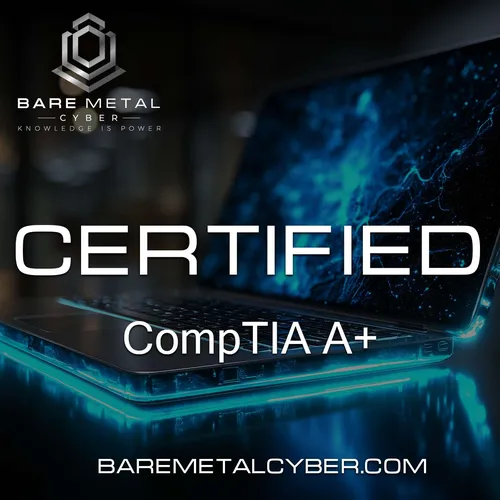
Certified - The CompTIA A+ Audio Course
The A+ Audio Course is your full-spectrum audio study guide for the CompTIA A+ certification (Core 1 and Core 2). Whether you're brand new to IT or brushing up before exam day, this podcast breaks down every topic in the official exam objectives into clear, structured, and accessible episodes. Each lesson focuses on what matters most—helping you understand, retain, and apply essential IT concepts, from hardware and networking to operating systems, security, troubleshooting, and professional procedures.
Designed for listening on the go, the A+ PrepCast covers over 130+ exam-focused episodes, including detailed walkthroughs, glossary deep dives, and domain-specific overviews. Episodes are crafted to support both visual and auditory learners, and align perfectly with the latest CompTIA exam version. Whether you're commuting, exercising, or prepping between classes, the A+ PrepCast turns your time into certification momentum. Brought to you by BareMetalCyber.com.
- Update frequency
- every day
- Average duration
- 12 minutes
- Episodes
- 140
- Years Active
- 2025

Episode 120: Domain 3.0 Software Troubleshooting — Overview
Troubleshooting software problems is a core responsibility in IT, and this episode introduces Domain 3.0 of the Core 2 exam. You’ll learn what kinds of software issues are covered, including applicat…

Episode 119: Data Disposal and Destruction Techniques
Properly disposing of storage media is a critical part of data security, and this episode outlines the methods you need to know. We begin with data wiping—using software to overwrite existing files—a…

Episode 118: Mobile and Embedded Device Security
Mobile and embedded devices require a tailored approach to security, and this episode explains how to apply protections without compromising usability. We begin with passcodes, biometrics, and auto-l…

Episode 117: Workstation Security Best Practices
Securing a user’s workstation is about more than antivirus—it involves a full spectrum of proactive configurations. This episode outlines best practices for maintaining a secure endpoint. We begin wi…

Episode 116: User Account Controls and SSO
In this episode, we cover two important mechanisms for managing user access and security: User Account Control (UAC) and Single Sign-On (SSO). We begin with UAC—how it prompts users before executing …

Episode 115: OS Security Settings — Defender, BitLocker, NTFS
Securing a system starts with built-in operating system tools, and this episode walks you through three key Windows security features. First is Windows Defender, which provides real-time protection a…

Episode 114: Threats and Vulnerabilities — Zero-Day, SQLi, XSS
This episode explains the technical underpinnings of some of the most dangerous threats and vulnerabilities in modern systems. We start with zero-day exploits, where attackers take advantage of unkno…

Episode 113: Social Engineering — Phishing, Impersonation, Tailgating
Not all threats are technical—some are psychological. This episode focuses on social engineering attacks, which trick users into revealing information or granting access through manipulation rather t…

Episode 112: Detection and Prevention — Antivirus, Firewalls, Education
Preventing malware infections involves more than just scanning files—it’s about layering multiple defenses. In this episode, we start with antivirus and antimalware software, explaining how they use …

Episode 111: Malware Types — Virus, Worms, Keyloggers, Rootkits
This episode dives into the various types of malicious software, or malware, that technicians must be able to recognize and address. We begin with viruses, which attach to legitimate files and requir…

Episode 110. Authentication — RADIUS, TACACS+, Kerberos
Authentication protocols ensure that users are who they say they are, and this episode covers three of the most important ones for the A Plus exam. We begin with RADIUS—Remote Authentication Dial-In …

Episode 109: Wireless Protocols — WPA2, WPA3, TKIP, AES
Wireless security standards are a frequent source of exam questions, and this episode breaks down the differences between key protocols. We start with WPA2 and WPA3, explaining how each provides encr…

Episode 108: Active Directory — Group Policy, Scripts, Domains
This episode introduces Active Directory (AD), Microsoft’s central system for managing users, computers, and security in domain-based environments. We explain how AD organizes resources into domains,…

Episode 107: Logical Security — MFA, ACLs, Tokens
In this episode, we move into the digital layer of defense, exploring logical security techniques that help ensure users access only what they’re authorized to. We start with multi-factor authenticat…

Episode 106: Physical Security — Locks, Guards, Surveillance
Protecting physical assets is the first line of defense in cybersecurity, and this episode explores the methods used to safeguard devices and facilities. We begin with door locks, cable locks, and bi…

Episode 105: Domain 2.0 Security — Overview
This episode introduces Domain 2.0 of the Core 2 exam: Security. We provide an overview of the key areas covered, including physical security measures, logical access controls, malware prevention, au…

Episode 104: Partitioning, Formatting, Feature Updates
This episode focuses on disk setup and system maintenance—key areas tested on the A Plus exam and vital for support professionals. We begin with partitioning: the process of dividing a physical disk …

Episode 103: Installation Methods — USB, PXE, Network, ISO
Installing an operating system requires choosing the right method for the environment, and this episode explores all the major approaches. We start with the most familiar: bootable USB drives created…

Episode 102. OS Life Cycle and Compatibility Concerns
Operating systems, like all software, go through a defined life cycle—from launch to end of support—and this episode walks you through what each stage means. We begin by outlining the general stages:…

Episode 101: Filesystems — NTFS, exFAT, ext4, APFS
This episode explores the filesystems used by various operating systems, each with its own capabilities and use cases. We begin with NTFS, the default for Windows, explaining its support for file per…